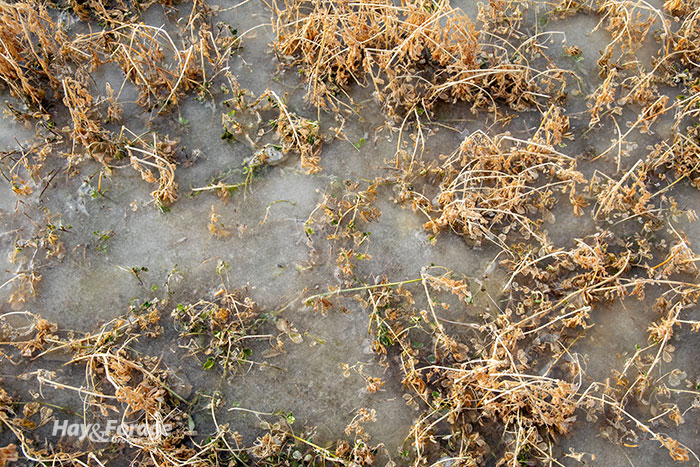
Although meteorological winter began on the first of the month, astronomical winter doesn’t commence for a couple weeks. Regardless of these calendar dates, the coldest season of the year is upon us, which means alfalfa may be at risk of winter injury and winterkill.
At the National Alfalfa & Forage Alliance’s (NAFA) Alfalfa Intensive Training seminar held last month in Arden Hills, Minn., Craig Sheaffer with the University of Minnesota said the causes of alfalfa winterkill can be divided into two categories: management induced or weather induced.
Choosing alfalfa varieties with suitable fall dormancy and winterhardiness ratings for a specific region can play a big part in winter survival. Likewise, careful fall cutting, proper fertilization, and overall stand maintenance will safeguard against winter injury and winterkill.
Winter weather, on the other hand, is out of a farmer’s control. Despite the steps taken to set alfalfa up for success through the season, issues can still arise from ice sheeting, alfalfa heaving, a lack of snow cover, and breaking dormancy too soon.
Ice sheeting: Ice sheeting can occur immediately after a winter rain when ponded water freezes over. It can also happen when snow melts and water percolates to the soil surface and turns to ice. Alfalfa plants continue to respire during the winter — albeit at a reduced rate — but ice sheeting inhibits gas exchange.
“Ice sheeting is the worst thing you can have,” Sheaffer stated. “You get an anaerobic condition that produces ethanol and other compounds that are toxic to the plant.” He noted some producers may try to break ice sheets by driving over fields with a harrow, but this practice could cause more damage than good.
Alfalfa heaving: While freezing and thawing cycles can incite ice sheeting, they can also cause alfalfa heaving. This expanding and contracting of the soil pushes plant crowns above the surface where they are exposed to frigid air.
Alfalfa plants develop crown buds in preparation for winter. Sheaffer explained this process, which is called contractile growth, sets the stage for regrowth in the spring. When crown buds are subject to alfalfa heaving, though, winter injury or winterkill could be the outcome.
Lack of snow cover: “If you don’t have any snow cover, you don’t have any insulation,” Sheaffer asserted. The agronomist from the Gopher State said soil temperatures below 15°F can be dangerous for alfalfa. That said, soil temperatures do not tend to drop as drastically as air temperatures — especially if there is enough snow on the ground.
According to a study in Minnesota, having 4 to 6 inches of snow cover maintained soil temperatures between 30°F and 35°F when air temperatures dropped below zero. Sheaffer suggested there is no such thing as too much snow; however, there could be a bigger risk of ice sheeting under a thicker blanket of white.
Leaving sufficient alfalfa stubble after the last cutting may help accumulate snow. Sheaffer added this stubble also shades the soil, which can help prevent a break in dormancy during periods of warmer weather in late winter or early spring.
Break in dormancy: If alfalfa does experience a period of warmer weather, plants can break dormancy too soon and start to put on vegetative growth ahead of schedule. It is when air temperatures return below freezing that plants will suffer from winter injury or winterkill.
In concluding, Sheaffer mentioned the effects climate change could have on alfalfa. While an uptick in average temperatures may potentially lengthen the growing season and narrow the window of opportunity for winterkill, a greater incidence of extreme rainfall events could be detrimental. He also noted El Niño is projected to bring warmer and wetter weather this season with the possibility of more snow in some parts of the U.S., but it is hard to know how this will impact alfalfa winter survival.

